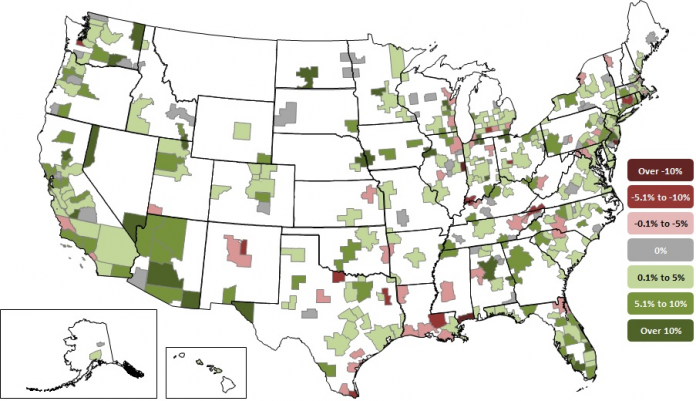Most of North Carolina experienced a modest rate of construction employment growth in the past year, but some Triad communities grew while the employment in the Charlotte area declined, according to US Bureau of Labor Statistics data analyzed by the Associated General Contractors of America (AGCA).
The Asheville area reported an eight percent growth rate (an additional 800) jobs, though the data for it and other smaller market area including Winston-Salem also includes mining and logging work. Asheville’s growth put it in 40th place nationally, while Winston-Salem, with a 7 percent growth (700 additional workers) ranked 52.
On the other end of the spectrum, construction employment in Charlotte declined by 3 percent, with a loss of 1,900 employees to 62,600 workers — resulting in the third highest employment rate decline in the nation.
The Research Triangle area reported a modest 1 percent employment growth.
Detailed data is below.
Table in order is: is Name of community, whether mining and logging are included, construction employment in May 2018, employment in May 2019, percentage increase (decrease), number of employees added (lost) and national ranking by employment growth (loss)
- Asheville, NC Mining, Logging, and Construction 9,600 10,400 8% 800 40
- Winston-Salem, NC Mining, Logging, and Construction 10,700 11,400 7% 700 52
- Fayetteville, NC Mining, Logging, and Construction 5,500 5,900 7% 400 52
- Myrtle Beach-Conway-North Myrtle Beach, SC-NC Mining, Logging, and Construction 10,400 10,900 5% 500 104
- Rocky Mount, NC Mining, Logging, and Construction 2,600 2,700 4% 100 135
- Virginia Beach-Norfolk-Newport News, VA-NC Mining, Logging, and Construction 38,200 39,200 3% 1,000 169
- Hickory-Lenoir-Morganton, NC Mining, Logging, and Construction 4,300 4,400 2% 100 196
- Durham-Chapel Hill, NC Mining, Logging, and Construction 8,700 8,800 1% 100 223
Greensboro-High Point, NC Mining, Logging, and Construction 15,600 15,700 1% 100 223 - Raleigh, NC Mining, Logging, and Construction 40,300 40,500 1% 200 245
Burlington, NC Mining, Logging, and Construction 2,900 2,900 0% 0 252
Wilmington, NC Mining, Logging, and Construction 8,900 8,900 0% 0 252
Charlotte-Concord-Gastonia, NC-SC Mining, Logging, and Construction 64,500 62,600 -3% -1,900 325
Overall, AGCA reports that construction employment grew in 249 out of 358 metro areas between May 2018 and May 2019, declined in 57 and was unchanged in 52. Association officials said firms in many parts of the country would likely have added more workers if it were not for an acute shortage of qualified workers.
“Many of our member firms report they are having a hard time finding qualified workers to keep pace with demand for construction services,” said Stephen E. Sandherr, the association’s chief executive officer. “Even though firms are raising pay, boosting training and adding hiring incentives to recruit workers, many are still struggling to find as many employees as they need.”
The Phoenix-Mesa-Scottsdale, Ariz. metro area added the most construction jobs during the past year (15,100 jobs, 12 percent). Other metro areas adding a large amount of construction jobs during the past 12 months include Los Angeles-Long Beach-Glendale, Calif. (9,200 jobs, 6 percent); Atlanta-Sandy Springs-Roswell, Ga. (8,600 jobs, 7 percent); Dallas-Plano-Irving, Texas (8,200 jobs, 6 percent) and Las Vegas-Henderson-Paradise, Nev. (6,300 jobs, 10 percent). The largest percentage gain occurred in Monroe, Mich. (25 percent, 500 jobs) followed by Auburn-Opelika, Ala. (20 percent, 500 jobs); Spokane-Spokane Valley, Wash. (18 percent, 2,600 jobs) and Davenport-Moline-Rock Island, Iowa-Ill. (17 percent, 1,700 jobs).
The largest job losses between May 2018 and May 2019 occurred in Baton Rouge, La. (-3,100 jobs, -6 percent), followed by Chicago-Naperville-Arlington Heights, Ill. (-2,800 jobs, -2 percent); Charlotte-Concord-Gastonia, N.C.-S.C. (-1,900 jobs, -3 percent) and Hartford-West Hartford-East Hartford, Conn. (-1,600 jobs, -8 percent). The largest percentage decrease took place in Danville, Ill. (-17 percent, -100 jobs) followed by Atlantic City-Hammonton, N.J. (-15 percent, -1,000 jobs); Gulfport-Biloxi-Pascagoula, Miss. (-14 percent, -1,200 jobs); and Longview, Texas (-9 percent, -1,400 jobs).
Association officials said Washington leaders can help address construction workforce shortages by increasing funding for career and technical education programs to recruit and train domestic workers. Congress should also pass comprehensive immigration reform that allows more people with construction skills to legally enter the country. Association officials added that the Trump administration’s decision to exclude construction from a new effort to make it easier to establish apprenticeship programs was a mistake.
“Instead of pushing every student into college, and college debt, Washington officials should make it easier for students to follow a debt-free path to high-paying construction careers,” Sandherr said. “And the Trump administration should reconsider its misguided decision to exclude the construction industry and its many thousands of available positions from its new apprenticeship program.”

